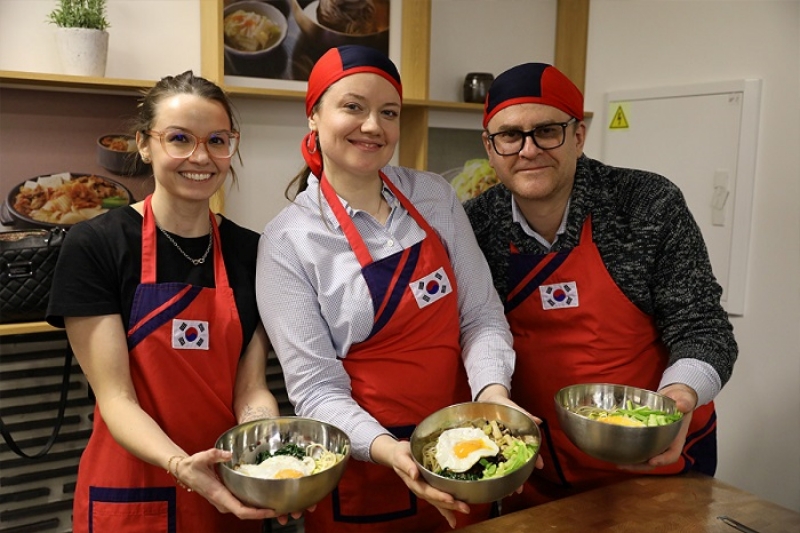
정부가 오는 2027년까지 글로벌 미식 트렌드 주도를 위한 한식 세계화를 추진한다. The government will push for the globalization of Hansik (traditional food) to have the domestic food sector lead global gastronomic trends by 2027.
농림축산식품부(농식품부)는 2일 서울 종로구 정부서울청사에서 열린 비상경제장관회의 겸 물가관계장관회의에서 ‘한식 산업 글로벌 경쟁력 강화 전략’을 발표했다.
The Ministry of Agriculture, Food and Rural Affairs on Feb. 2 at Government Complex-Seoul announced strategies to bolster the global competitiveness of domestic cuisine at an emergency meeting of economy-related ministers
이번 전략에서 정부는 2021년 152조 원 수준이던 세계 한식산업 규모를 2027년까지 300조 원 수준으로 성장시키겠다는 목표를 내놨다. 해외 한식당 수도 2020년 9923개에서 2027년 1만5000개로 확대하고 지난해 21곳이었던 미쉐린 스타급 우수 한식당 수도 100곳으로 늘린다.
A major goal of the plans is nearly doubling the sector’s scale from KRW 152 trillion in 2021 to KRW 300 trillion by 2027. Another is to raise the number of Korean restaurants abroad to 15,000 by 2027 from 9,923 in 2020, with that of Michelin-starred establishments to surge from 21 in 2023 to 100 by 2027.
이를 위해 농식품부는 한식 산업 인프라 강화, 한식 가치 제고, 한식 산업 생태계 확장 등 3가지 전략을 추진키로 했다.
For this purpose, the ministry’s three strategies are to strengthen the industry’s infrastructure, upgrade the value of Hansik and expand the sector’s ecosystem.
먼저 정부는 한식 전문인력 양성기관 5곳, 250여 명에 대한 지원을 2027년까지 8곳, 600명으로 늘린다. 해외 유명 요리학교 내 정규 한식 조리과정 개설을 올해 2곳에서 2027년 5곳까지 확대하는 등 해외 한식 우수 인력 양성에도 힘쓴다.
First, the number of organizations for training Korean food specialists will be raised from five with some 250 staff to eight and 600 by 2027. More efforts will also go toward developing outstanding Hansik experts overseas through the opening of regular classes on Korean cooking at five world-renowned culinary schools by 2027, up from two this year.
또 대표적인 한식 100개의 조리법을 디지털화하고 전통주 페어링 등 다양한 수요를 반영한 콘텐츠를 제공한다. 한식 가치 확산을 위한 브랜드 키워드로 선정된 ‘어드벤처러스 테이블(Adventurous Table)’에 대한 브랜드 로고도 상반기에 공개할 예정이다.
The ministry will digitize the recipes of 100 leading Korean foods and provide content by reflecting the range of demand for Hansik like pairing food with traditional alcoholic beverages. By the first half of this year, it will also unveil the brand keyword “Adventurous Table” to spread the value of Korean food.
한식 용어를 한국어 표기 그대로 세계 각국에 알릴 수 있도록 쌈장, 막걸리 등 10대 한식 용어를 정하는 한편, 올해 3월 중으로 국내 최초 ‘아시아 50 베스트 레스토랑’ 등 국제 미식 행사를 개최하기로 했다.
To promote to the world the Korean terms for domestic foods, ten such words will be selected such as ssamjang, or thick and spicy paste made with soybean paste, and makgeoli (milky rice wine). In March, the nation will also host its inaugural global gastronomy event “Asia’s 50 Best Restaurants.”
특히 농식품부는 전 세계 상위 1% 한식당 100곳을 ‘해외 우수 한식당’으로 지정하고 국내의 경우 음식 품질·위생 등을 평가하는 외식 서비스 등급제를 운영할 계획이다.
The ministry will designate the top 100 Korean restaurants abroad comprising the world’s best 1% and launch a service rating system to assess food quality and sanitation at domestic restaurants.
이와 함께 한식과 농업, 관광, 문화·예술 등을 연계한 ‘K-미식벨트’를 조성해 미식 관광 활성화에 나선다. 올해 안으로 K-미식벨트 1곳을 시범 조성하고 2027년에는 15개로 늘린다는 방침이다.
The formation of a “K-gourmet belt” will link Korean food, agriculture, tourism, and culture and arts and boost culinary tourism. The plan is to launch a pilot belt this year and raise the number of such regions to 15 by 2027.
송미령 농식품부 장관은 “한식 산업이 K-컬처 열풍에 힘입어 글로벌 미식메가 트렌드를 주도하는 산업으로 굳건히 자리매김하도록 모든 정책적 역량을 기울이겠다”고 밝혔다.
Minister of Agriculture, Food and Rural Affairs Song Mi-ryung said, “We will devote all of our policy capacity to firmly position Hansik as a sector that leads global gastronomic megatrends backed by the ‘K-Culture’ craze.”
박혜리 기자 hrhr@korea.kr
By Park Hye Ri, hrhr@korea.kr
